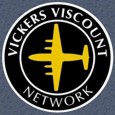
January 1955 to June 1964
Trans-Canada Air Lines (TCA)
CF-TGJ - c/n 41 - a V.724 series Viscount
Canada registered
November 1952
An order was placed by Trans-Canada Air Lines (TCA) for fifteen Type 724 aircraft at a total cost of Can$11,500,000. This was the second one built.
Production Aircraft No. 46 - the 46th production Type 700 series Viscount built,
was the 32nd Viscount fuselage assembled at Weybridge, Surrey, England,
and the 26th Viscount assembled at Weybridge, Surrey, England.
Production Order No. F02/724. Sales Order No. F02/51B. Stock Order No. F06/21B.
13 April 1954
Fuselage assembly commenced at Weybridge, Surrey, England.
7 June 1954
Fuselage to Erecting Shop 'E' at Weybridge, Surrey, England.
24 December 1954
First flight from Brooklands Airfield, Weybridge, Surrey, England.
It was fitted with Rolls-Royce Dart RDa3 Mark 506 engines.
It landed at Wisley Airfield, Surrey, England for fitting out and test flying.
28 January 1955
Aircraft passed off by TCA inspectors as completed and ready for delivery.
30 January 1955
Departed from Wisley Airfield, Surrey, England on delivery to Trans-Canada Air Lines (TCA) with fleet number '602'.
After refuelling at Prestwick Airport, Ayrshire, Scotland it then flew on to Keflavik Airport, Iceland (743 nautical miles) where it stopped overnight.
31 January 1955
Departed from Keflavik Airport, Iceland to Bluie West One (BW1) Airfield, Narsarsuaq, Southern Greenland (804 nautical miles), Goose Bay Airport, Newfoundland & Labrador, Canada (672 nautical miles), Dorval International Airport, Montreal, Province of Quebec, Canada (810 nautical miles).
BW1 was built during WWII to assist the transfer of military aircraft from North America to Europe and was opened in January 1942.
The aircraft then went to Winnipeg Airport, Manitoba, Canada.
The cabin was fitted out with 40 seats which was a reduction from the original 48 seat specification and provided more leg room.
This was heavily marketed and resulted in a high load factor compared to the 18 seat Douglas DC-3 that it replaced on some routes.
21 March 1955
TCA issued technical instruction V-05.04-1/1 to apply the word 'Viscount' to the tail section in 8.5 inch high red letters edged in white at the first opportunity.
This aircraft had the word 'Viscount' on the tail in an unusual position lower down on the tail, but it was soon moved to the standard position higher up.
16 May 1955
After a training flight the undercarriage collapsed on landing back at Winnipeg Airport, Manitoba, Canada.
The aircraft had taken off from Runway 18 with the No.1 propeller feathered. There were three pilots on board, and once airborne the undercarriage was retracted but it stayed in the down position.
The undercarriage was cycled but nothing changed. The visual indicators and the three green lights showed that the undercarriage was safely locked down.
On landing with the No.1 propeller still feathered the undercarriage slowly retracted resulting in damage to the lower fuselage and the propellers and shockload damage to the Rolls-Royce Dart engines.
The No.2 propeller actually detached from the aircraft when it made contact with the runway.
The cause of the initial failure to retract the undercarriage was not determined, but the collapse on landing was due to the undercarriage select lever being left in the 'up' position.
Repaired and returned to service.
2 June 1955
TCA issued technical instruction V-31.02-2/5 to apply the word 'Viscount' to the inside of the passenger loading door in 4 inch high red letters edged in white at the first opportunity.
8 August 1955
Operated the first Viscount service from Dorval International Airport, Montreal, Province of Quebec, Canada to Idlewild Airport, New York, USA, under the command of Captain A Hollinsworth. This was a three times a day service.
July 1956
Cabin interior changed to a two class 44 seat arrangement.
10 July 1957
TCA issued instructions that all Viscounts would be repainted in a 'White Top' livery when a suitable maintenance period became available.
3 July 1958
Scheduled to enter the Winnipeg Airport, Manitoba, Canada TCA maintenance facility for the replacement of the life expired wing lower inner spar boom at approximately 6080 landings for this component. This usually took 28 days to complete.
31 August 1960
Total time 13,568 hours and 10,644 total landings.
7 January 1963
Withdrawn from service and stored at Winnipeg Airport, Manitoba, Canada.
Total time 17,757 hours and 14,427 total landings.
30 September 1963
Noted being towed out of storage still in basic TCA livery but with the titles painted out on the fuselage.
Shortly afterwards it was ferried to Timmins Aviation Ltd at Dorval International Airport, Montreal, Province of Quebec, Canada for conversion to Model V.744 standard to comply with FAA regulations. A set of expanding type integral front 'airsteps' was also fitted. This work was carried out under technical instructions from TCA.
Rolls-Royce Dart RDa3 Mark 506 engines fitted at that time were: -
No.1 S/N 3335 TSN 11977.35, TSO 0,
No.2 S/N 3311 TSN 8343.21, TSO 328.33,
No.3 S/N 3259 TSN 14317.38, TSO 0,
No.4 S/N 3248 TSN 10496.16, TSO 0
25 April 1964
TCA removed this aircraft from their fleet inventory ready for disposal.
3 June 1964
Test flown by Timmins Aviation Ltd as a V.744 from Dorval Airport, Montreal, Province of Quebec, Canada.
15 June 1964
Sold to Air Transport Leasing Corporation.
|



